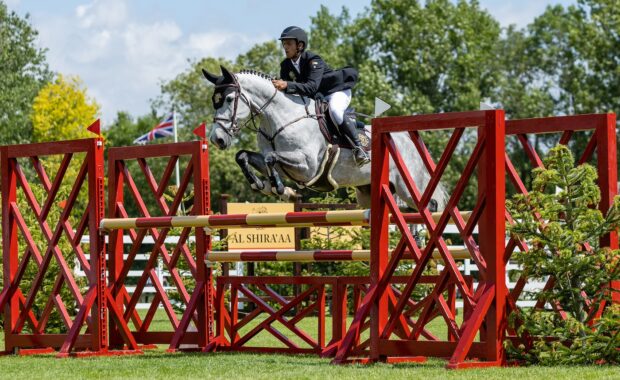The Hickstead Derby course remains the same year after year. It is much longer than your average showjumping course at 1,195m, and includes 21 jumping efforts around the 16-fence course, including the famous 10ft 6in high Derby Bank.
Fence 1: The Cornishman (4ft 8in)

This solid stone wall with a pole on top looks easy, but it has caused plenty of mistakes over the years
Fence 2: white oxer (4ft 3in high; 6ft 6in wide)

A very wide fence to meet so early on the course, hidden behind the Irish bank as riders jump fence No.1 so horses don’t get a long approach
Fence 3: double of water ditches (5ft and 5ft 2in high, both with ditches in front)

So many hopes have been dashed here. The water is dyed blue and the reflection makes the fences even more difficult when the sun comes out
Fence 4: black gate (5ft 3in)

A maximum-height, extremely upright fence that falls easily
Fence 5: wall (5ft 3in)

Also at maximum, but usually jumps well
Fence 6: privet hedge oxer (4ft 11in high; 6ft 6in wide)

Another wide fence jumped away from the entrance. It is better now the hedge has been trimmed, but some horses still try to bank it
Fence 7: road jump (a table fence 5ft high with a ditch behind and a 5ft 2in high exit with a ditch in front)

A closed obstacle, which means that if a horse stops, riders cannot leave the fence’s confines to try again. The ditches can confuse horses in their first Derby
Fence 8: Derby Bank (10ft 6in high with a 3ft 5in rail on top)

The one all the spectators are waiting for. The small fence on top is only 16ft from the edge and horses sometimes roll a pole there because their riders are trying to slow down before arriving at the edge.

Horses slide down the face of the Bank and riders hope to jump off about halfway down, which will put them right for a nice two strides to the next problem
Fence 9: white rails (5ft 3in high)

One of the most influential fences. Clearing it depends on getting the descent of the Bank spot on
Fence 10: Devil’s Dyke (a closed rustic obstacle. 4ft 9in rails; 4ft 9in rails over a water ditch; 4ft 8in rails)

This is the one every rider wants out of the way. Because it is all the same colour, it can look like one big obstacle to the horse. And although the rails coming out measure only 4ft 8in high, the sloping ground makes them nearer 6ft
Fence 11: open water (15ft wide)

A difficult fence because it is jumped away from the entrance and some horses think they have finished after the previous fence
Fence 12: Derby rails (5ft 3in high)

These fall very easily. Most riders aim at the post in between
Fence 13: open ditch (5ft 1in high; 6ft wide)

Horses sometimes look in the 3ft ditch and forget to get their legs high enough to clear the rustic poles
Fence 14: balustrades (5ft 3in high)

Set downhill and a difficult fence to jump on a tired horse
Fence 15: double of gates (first part 4ft 10in high; second part 4ft 10in high and 5ft 6in wide)

This is on a long distance and horses find it hard to make the spread on part two
Fence 16: rustic spread (4ft 10in high; 6ft 6in wide)

Another wide fence that has ruined many dreams. It is a long way after the double and riders often approach at speed because they are worried about time-faults.
Getting to Hickstead
From the north: travel south on the A23. Pass the Burgess Hill/Hickstead Village turn off. Take the next exit (B2118) and bear right over the flyover. Take the third exit at the roundabout. The showground entrance is 100m on the left.
From the south: leave the A23 at the junction marked B2117 for Hurstpierpoint. Turn left and after 200m turn right on to the B2118. Follow this road for 2.5miles. The showground entrance is 100m on the left after the third roundabout.


